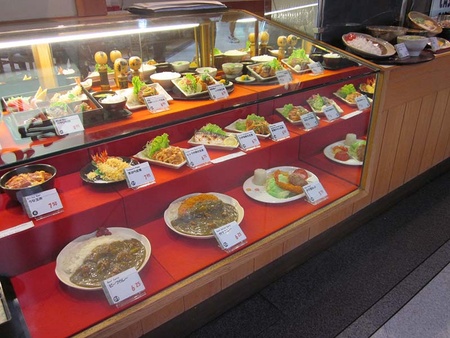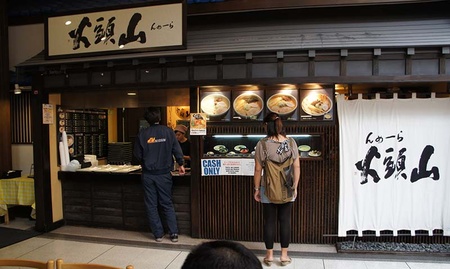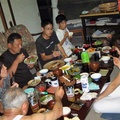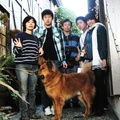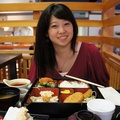The trick is to first empty one packet of “gu” into a small bowl, then pour in hot water (around 160ml). Then, add the miso packet and stir well.1
These are the directions from my instant miso-soup packets—a modern invention of freeze dried wakame, tofu, onion and non-perishable miso purchased from Mitsuwa Marketplace in Torrance, California that gives my taste buds a small journey to my homeland, Japan. Mitsuwa is an amazing place. In entering the Japanese supermarket, I am surrounded by Nihon. The familiar smells of fresh sashimi and vegetables, the sight of kanji, the sounds of J-pop, and of course the endless shelves of Japanese snacks teasing my hungry stomach. Perhaps even more enticing is their food court that has no hint of McDonald’s or Taco Bell, but instead lures me with its beautiful displays of Hokkaido ramen, wafuu teishoku (Japanese lunchboxes), and shrimp tempura bowls.
Throughout my sixteen years as a Japanese immigrant in America, I have been to five of the eight Mitsuwa locations spread across California to New Jersey. Upon this strange realization, I thought, “Was Mitsuwa following me or was I following Mitsuwa?” As I look back at my countless moves from San Jose to the East Coast, back to San Jose, San Diego, and now Los Angeles, I now see that I am possibly the epitome of the new Japanese diaspora in America.2 Wherever large Japanese communities formed, a Japanese market such as Mitsuwa was bound to follow, consequently drawing more immigrants into these ethnic suburbs now sometimes called “ethnoburbs.”
A great example of a booming Japanese ethnoburb is Torrance, California. Located in Los Angeles County, Torrance holds the national headquarters for many large Japanese corporations such as Toyota Motor Sales, Honda Motor Company, All Nippon Airway (ANA), as well as smaller corporations such as Lighthouse Magazine and Mitsuwa Marketplace. Mitsuwa in Torrance is soon entering its 19th year of existence, serving the Nikkei community longer than my family has been in the United States.3 As there is clearly a strong Nikkei presence in Torrance, I am interested in exploring how and why this Mitsuwa and particularly its food court, as a community gathering place, exemplify the Japanese diaspora in the United States.
Anthropologist Purnima Mankekar, in her article “’India Shopping’: Indian Grocery Stores and Transnational Configurations of Belonging,” argues that the ethnic grocery store provides its customers with not just the material and tangible ingredients for cooking, but “also make[s] available a range of objects, artifacts, images, and discourses for consumption.”4 This ethnic space created by the Mitsuwa food court is a “site of public culture” for both the insider Nikkei community as well as the outsider non-Nikkei public, that both “invoke[s] and produce[s] powerful discourses of home, family, and community.”5 Her findings in her ethnography of transnationality on the Indian markets are comparable to the situation I observed at the Mitsuwa Marketplace in Torrance. In my study, I found that the Nikkei and non-Japanese alike are coming to Mitsuwa to consume not just the ethnic grocery goods, but also the entire atmosphere from the people to the interior decoration, in order to be part of a temporary transnational journey to Japan and to its culture.
Through this preliminary study of Mitsuwa in Torrance, California, I hope to 1) highlight the historical links between the Japanese immigrants and Mitsuwa in America, 2) illustrate the Japanese atmosphere created in Restaurant Row of Mitsuwa, focusing on the restaurants Santouka and Miyabi-Tei, and 3) using Purnima Mankekar’s theory, draw conclusions about the transnational nature of ethnic foods that takes its consumers far beyond the tangible here and now.
History: Migration, Legacy, and Tradition
My earliest memory of Mitsuwa is that it was not “Mitsuwa,” but another Japanese supermarket called “Yaohan.” Yaohan, though fairly established worldwide after World War II, hinting at the preexisting Japanese diaspora, went into a sharp decline with the fall of the Japanese economy in the late 1990s and was bought off by newer corporations such as Mitsuwa and Marukai. Today, Mitsuwa, Marukai, and Nijiya are the three largest Japanese supermarket companies of America, competing in fairly the same geographical locations, sometimes only blocks away from each other.6 Typically, they are centered around the Japanese American and Shin-Issei communities of San Jose and Southern California.7
However, outside of California, the existence of the Japanese markets holds even stronger implications about the Nikkei diaspora in the United State. Responding to the growing Japanese population in the East Coast, Mitsuwa of New Jersey is the largest Mitsuwa supermarket in the nation, drawing in not just the locals but people like my family in Virginia who craved a taste of “home” so badly as to make it a destination during a road-trip. There is also a location in Chicago that serves Illinois’s Japanese immigrant community as well.
Although the three competing markets all promote themselves in different ways such as through membership discounts or sales, Mitsuwa is the only market to provide a food court (called Restaurant Row) inside their marketplace, luring not just grocery shoppers but also those who seek Japanese food. At Restaurant Row of this particular Mitsuwa, there are seven different food establishment. When asked to name a type of Japanese food, often the first thing that pops into one’s mind is sushi. However, Restaurant Row offers much more than just fresh sushi. One can choose among “Curry Club” (Japanese curry), “Katsu-Hana” (tempura, pork and chicken katsu), “Mi-Fune” (udon, soba), “Italian Tomato” (sandwiches and pastas), “Miyabi-Tei” (Japanese curry and obento), and “Santouka” (ramen).
Though these various cuisines are all very enticing with their beautifully crafted displays of their foods and reasonable pricing, for the purposes of this essay, I will focus on Miyabi-Tei and Santouka—arguably the most distinctive two—in order to compare and contrast different approaches to selling Japanese cuisine to a diverse clientele.
Miyabi-Tei and Santouka, located against different walls of Restaurant Row, approach their marketing strategy somewhat differently. Miyabi-Tei markets itself as “traditional Japanese cuisine” even though their restaurant is not particularly a thriving chain back in Japan. Santouka is quite the opposite. It is a Hokkaido Ramen chain, started in 1988 that has now made its way not just into the main island of Honshu, but also to the United States, Canada, Singapore, and Hong Kong. Santouka has a bilingual homepage on the web, whereas Miyabi-Tei’s information in cyberspace is limited to food reviewers on Yelp and other restaurant review websites.8 Miyabi-Tei has only two locations at the eight Mitsuwas nationwide while Santouka has a shocking seven locations. Santouka has “legendary” founder Hitoshi Hatanaka attached to their enterprise, whereas Miyabi-Tei’s history is not as easily traceable.9 When I asked about the peculiar backwards lettering of Santouka to a worker inside, he responded, “In the past, they wrote it that way!” further alluding to their long and traceable history. In stark comparison, when I asked a worker at Miyabi-Tei about their restaurant’s history, he was not even sure how long their store had been at Mitsuwa.10 With these clearly different trajectories, not just in the food that they serve but also in the way they market themselves as “legendary” or “traditional,” it is interesting to see how they cater to the desires of their clientele, fulfilling not just their stomachs but also their emotions.
Notes:
1. Author’s translation. The directions were actually half covered by an opaque white sticker of Nutrition facts written in English, and I had to flip the bag inside-out to read the Japanese print.
2. My father was a Japanese expatriate, working for a multinational corporation that had him moving every two to five years.
3. “Mitsuwa Past Event Information,” Mitsuwa Marketplace, accessed Mar. 2, 2011, http://www.mitsuwa.com/eventold/eindex.php.
4. Purnima Mankekar, “ ‘India Shopping’: Indian Grocery Stores and Transnational Configurations of Belonging,” The Cultural Politics of Food and Living, A Reader (2005): 201.
5. Mankekar, “India Shopping,” 203, 210.
6. In San Diego, Mitsuwa, Marukai, and Nijiya are all located in the famous Asian neighborhood of “Convoy.” Convoy is a single street, but block after block, there are food joints, karaoke boxes, video rental shops, and goodie shops, of all types of Asian ethnicity.
7. Interestingly, the dwindling Japanese community of Little Tokyo brought their Mitsuwa to a closure in 2009. However, there is still a small Nijiya located at the heart of Little Tokyo.
8. Santouka’s website is harder to search in English, though. It was the first hit in google search for “山頭火” but with “Santouka,” the website did not appear until the 2nd page.
9. “Ramen Santouka- The Birth of a Legend,” Santouka, accessed Mar. 2, 2011, http://www.santouka.co.jp/en/history/index.html.
10. Granted, the person I had access to was a part-time worker around early to mid-twenties. He guessed that Miyabi-Tei has been in existence for around ten years.
© 2011 Eri Kameyama


